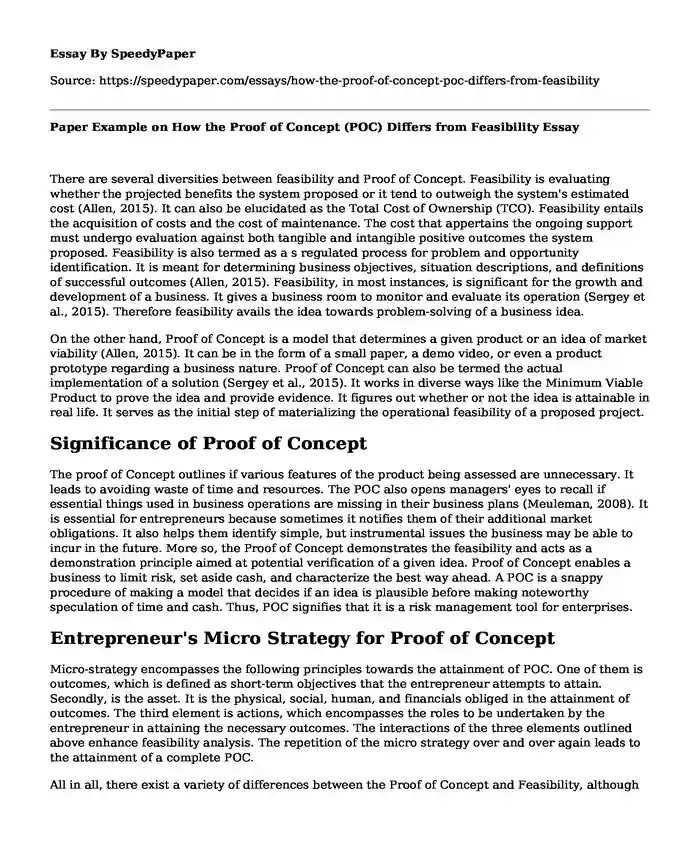
| Essay type: | Persuasive essays |
| Categories: | Goal Business Business strategy |
| Pages: | 3 |
| Wordcount: | 646 words |
There are several diversities between feasibility and Proof of Concept. Feasibility is evaluating whether the projected benefits the system proposed or it tend to outweigh the system's estimated cost (Allen, 2015). It can also be elucidated as the Total Cost of Ownership (TCO). Feasibility entails the acquisition of costs and the cost of maintenance. The cost that appertains the ongoing support must undergo evaluation against both tangible and intangible positive outcomes the system proposed. Feasibility is also termed as a s regulated process for problem and opportunity identification. It is meant for determining business objectives, situation descriptions, and definitions of successful outcomes (Allen, 2015). Feasibility, in most instances, is significant for the growth and development of a business. It gives a business room to monitor and evaluate its operation (Sergey et al., 2015). Therefore feasibility avails the idea towards problem-solving of a business idea.
On the other hand, Proof of Concept is a model that determines a given product or an idea of market viability (Allen, 2015). It can be in the form of a small paper, a demo video, or even a product prototype regarding a business nature. Proof of Concept can also be termed the actual implementation of a solution (Sergey et al., 2015). It works in diverse ways like the Minimum Viable Product to prove the idea and provide evidence. It figures out whether or not the idea is attainable in real life. It serves as the initial step of materializing the operational feasibility of a proposed project.
Significance of Proof of Concept
The proof of Concept outlines if various features of the product being assessed are unnecessary. It leads to avoiding waste of time and resources. The POC also opens managers' eyes to recall if essential things used in business operations are missing in their business plans (Meuleman, 2008). It is essential for entrepreneurs because sometimes it notifies them of their additional market obligations. It also helps them identify simple, but instrumental issues the business may be able to incur in the future. More so, the Proof of Concept demonstrates the feasibility and acts as a demonstration principle aimed at potential verification of a given idea. Proof of Concept enables a business to limit risk, set aside cash, and characterize the best way ahead. A POC is a snappy procedure of making a model that decides if an idea is plausible before making noteworthy speculation of time and cash. Thus, POC signifies that it is a risk management tool for enterprises.
Entrepreneur's Micro Strategy for Proof of Concept
Micro-strategy encompasses the following principles towards the attainment of POC. One of them is outcomes, which is defined as short-term objectives that the entrepreneur attempts to attain. Secondly, is the asset. It is the physical, social, human, and financials obliged in the attainment of outcomes. The third element is actions, which encompasses the roles to be undertaken by the entrepreneur in attaining the necessary outcomes. The interactions of the three elements outlined above enhance feasibility analysis. The repetition of the micro strategy over and over again leads to the attainment of a complete POC.
All in all, there exist a variety of differences between the Proof of Concept and Feasibility, although both are connected and interdisciplinary. Both POC, Feasibility, and Micro strategies require the support of one another to attain the set business goals. Therefore, it is fundamental for business ventures to have Proof of Concept, feasibility, and micro strategies when designing their business ideas for positive results.
References
Allen, K. R. (2015). Launching new ventures: An entrepreneurial approach. Nelson Education.
Meuleman, L. (2008). Public management and the meta governance of hierarchies, networks, and markets: The feasibility of designing and managing governance style combinations. Springer Science & Business Media.
Sergey, A. B., Alexandr, D. B., & Sergey, A. T. (2015). Proof of concept center—a promising tool for innovative development at entrepreneurial universities. Procedia-Social and Behavioral Sciences, 166, 240-245.
Cite this page
Paper Example on How the Proof of Concept (POC) Differs from Feasibility. (2023, Nov 14). Retrieved from https://speedypaper.com/essays/how-the-proof-of-concept-poc-differs-from-feasibility
Request Removal
If you are the original author of this essay and no longer wish to have it published on the SpeedyPaper website, please click below to request its removal:
- Essay Example on Presentation Skills on YouTube
- Making Good Choices Essay Samples
- Research Paper Sample on the Physical Education of Students with Disabilities
- Free Essay Answering Why E-Sports Is Good for College Students
- Quality Improvement Strategies With Six Sigma - Essay Example
- Essay Example: Powered Industrial Truck Standard
- Paper Example: The Issue of Communication in the Family
Popular categories




